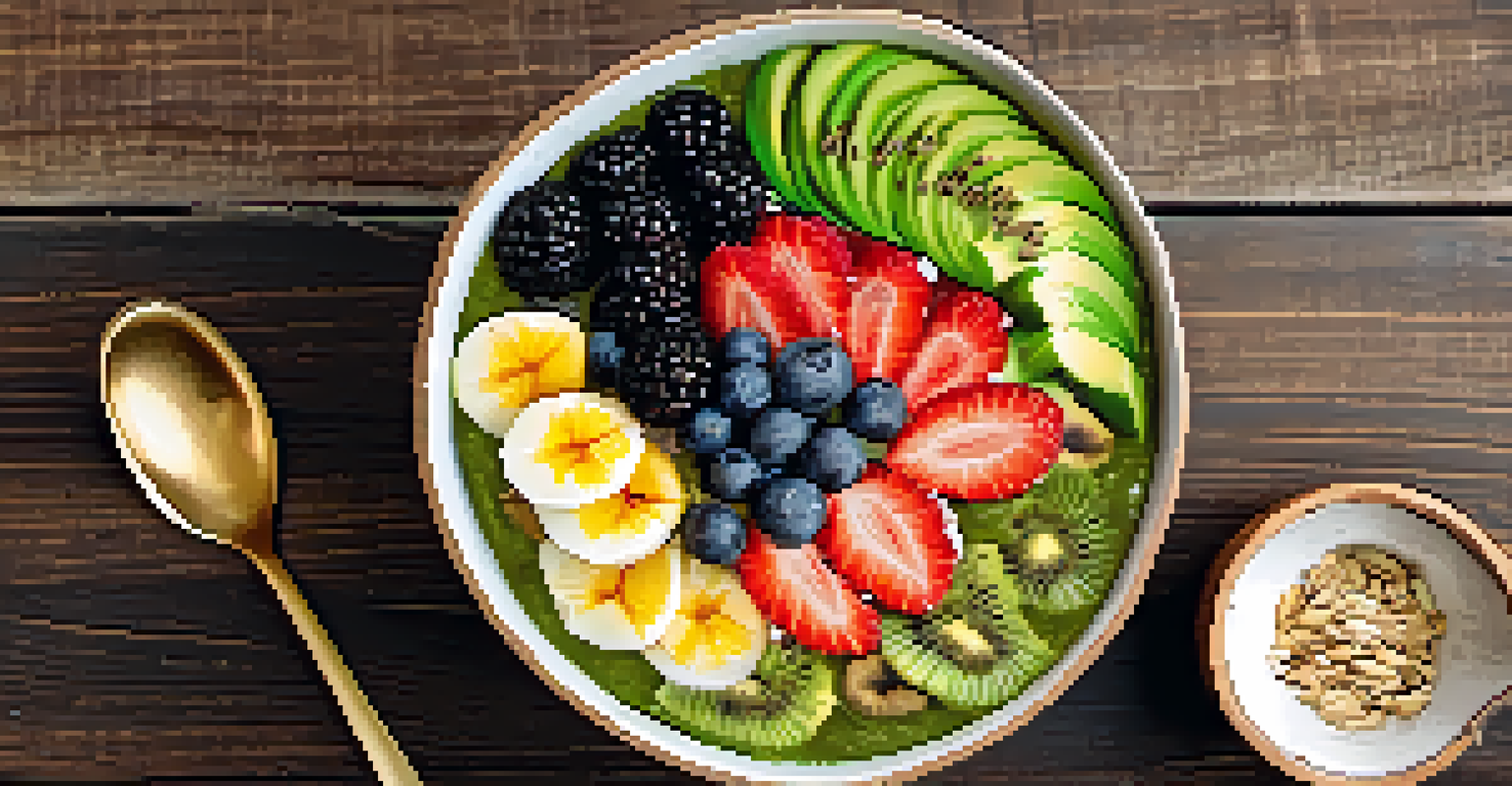Understanding Raw Food: A Path to Sustainable Weight Control

What is Raw Food and Its Core Principles?
Raw food refers to uncooked, unprocessed foods that are often organic and plant-based. This diet typically includes fruits, vegetables, nuts, seeds, and sprouted grains, emphasizing natural ingredients. The core principle of raw foodism is that cooking destroys vital nutrients and enzymes, making food less beneficial for health.
Let food be thy medicine and medicine be thy food.
For many raw food enthusiasts, the idea is to consume food as close to its natural state as possible. Think of it like eating a salad versus a cooked vegetable dish; the salad retains more of its nutrients. By focusing on raw foods, individuals can experience a diet rich in vitamins, minerals, and antioxidants that promote overall well-being.
Moreover, raw food diets can vary widely, allowing for creativity in meal preparation. From smoothies to salads and raw desserts, there's a vast range of delicious options to explore. This flexibility can make the transition to a raw food lifestyle enjoyable and fulfilling.
The Connection Between Raw Food and Weight Control
One of the most appealing aspects of a raw food diet is its potential for weight control. The high fiber content in raw fruits and vegetables can help you feel full longer, reducing the urge to snack on less nutritious options. This can lead to a natural decrease in calorie intake without the need for strict dieting.

Additionally, raw foods are generally low in calories but high in volume, which means you can eat more while consuming fewer calories overall. Imagine filling your plate with colorful salads or smoothie bowls; you get to enjoy large portions without the guilt. This approach can help create a sustainable weight management strategy over time.
Raw Food Promotes Nutritional Health
Raw foods retain essential nutrients and enzymes, supporting overall health and wellness.
Moreover, the emphasis on whole, unprocessed foods can help stabilize blood sugar levels, reducing cravings and promoting consistent energy levels. When you're not constantly battling sugar spikes and crashes, it becomes easier to maintain a healthy weight.
Nutritional Benefits of Raw Foods
Raw foods are packed with essential nutrients that support overall health. Because they are minimally processed, they retain more vitamins, minerals, and antioxidants compared to their cooked counterparts. For instance, vitamin C, often found in fruits and vegetables, can diminish with heat exposure during cooking.
You are what you eat, so don’t be fast, cheap, easy, or fake.
Incorporating more raw foods into your diet can provide a wealth of benefits, such as improved digestion, increased energy, and enhanced skin health. The enzymes present in raw foods can aid digestion, making nutrient absorption more efficient. Imagine feeling more energized and vibrant simply by choosing to eat foods in their natural form.
Furthermore, a raw food diet is often rich in water content, helping to keep you hydrated. Staying hydrated is crucial for maintaining healthy skin, optimal digestion, and overall bodily functions. By embracing raw foods, you're not just focusing on weight control; you're also investing in your long-term health.
How to Transition to a Raw Food Diet
Transitioning to a raw food diet doesn't have to happen overnight. Start gradually by incorporating more raw fruits and vegetables into your meals. You might begin with a simple breakfast smoothie or a fresh salad for lunch, making small changes that feel manageable.
As you become more comfortable, experiment with raw recipes and techniques, such as sprouting nuts or making raw desserts. This exploration can make the process exciting and help you discover new flavors and textures. Think of it as an adventure in the kitchen, where each meal is an opportunity to try something different.
Weight Control with Raw Foods
The high fiber and low-calorie nature of raw foods can help with weight management by promoting fullness.
Remember, it's essential to listen to your body during this transition. Everyone's nutritional needs are different, and some may require a more balanced approach by including cooked foods. The key is to find what works best for you while enjoying the journey toward a healthier lifestyle.
Common Misconceptions About Raw Food Diets
Despite its benefits, there are several misconceptions about raw food diets. One common myth is that they are overly restrictive and lacking in variety. In reality, raw food diets can be incredibly diverse, offering a wide range of flavors, textures, and meal options. From zoodles (zucchini noodles) to raw tacos, the possibilities are endless.
Another misconception is that raw food diets lack protein. While it's true that some protein sources are cooked, there are plenty of raw options available, such as nuts, seeds, legumes, and even certain grains when sprouted. A well-planned raw food diet can easily provide all the necessary nutrients, including protein.
Finally, some people believe that raw food diets are not sustainable long-term. However, many individuals maintain this lifestyle for years, enjoying the health benefits it offers. It's all about finding a balance that works for you, allowing for flexibility and occasional cooked meals if needed.
Potential Challenges of a Raw Food Diet
While raw food diets offer numerous benefits, they can also present challenges. One of the main difficulties is the time commitment required for meal preparation. Raw meals often involve more chopping, blending, and sprouting, which can feel overwhelming for those with busy schedules. Planning and preparing meals in advance can help mitigate this issue.
Additionally, social situations may pose challenges for raw food enthusiasts. Dining out or attending gatherings can make it tricky to stick to a raw food diet, especially if options are limited. However, bringing your own dish or choosing restaurants with healthy selections can help you navigate these social scenarios.
Mindfulness Enhances Raw Food Diet
Practicing mindfulness during meals fosters a deeper appreciation for food and supports healthier eating habits.
Lastly, it's important to consider individual nutritional needs. Some people may require additional nutrients that could be harder to obtain solely from raw foods. Consulting with a nutritionist can provide guidance to ensure you're meeting your body's requirements while enjoying the benefits of a raw food lifestyle.
The Role of Mindfulness in a Raw Food Lifestyle
Mindfulness plays a crucial role in embracing a raw food lifestyle. By being present during meals and focusing on the flavors, textures, and colors of your food, you can cultivate a deeper appreciation for what you're eating. This awareness helps you to enjoy your meals more and encourages healthier eating habits.
Practicing mindfulness can also assist in recognizing hunger and fullness cues, which is vital for sustainable weight control. Instead of eating on autopilot, take the time to savor each bite, allowing your body to signal when it's satisfied. This practice can help prevent overeating and promote a healthier relationship with food.

Moreover, mindfulness extends beyond meals to your overall lifestyle. Engaging in activities like yoga, meditation, or simply spending time in nature can enhance your connection to your body and mind. This holistic approach can make your journey toward sustainable weight control feel more fulfilling and balanced.